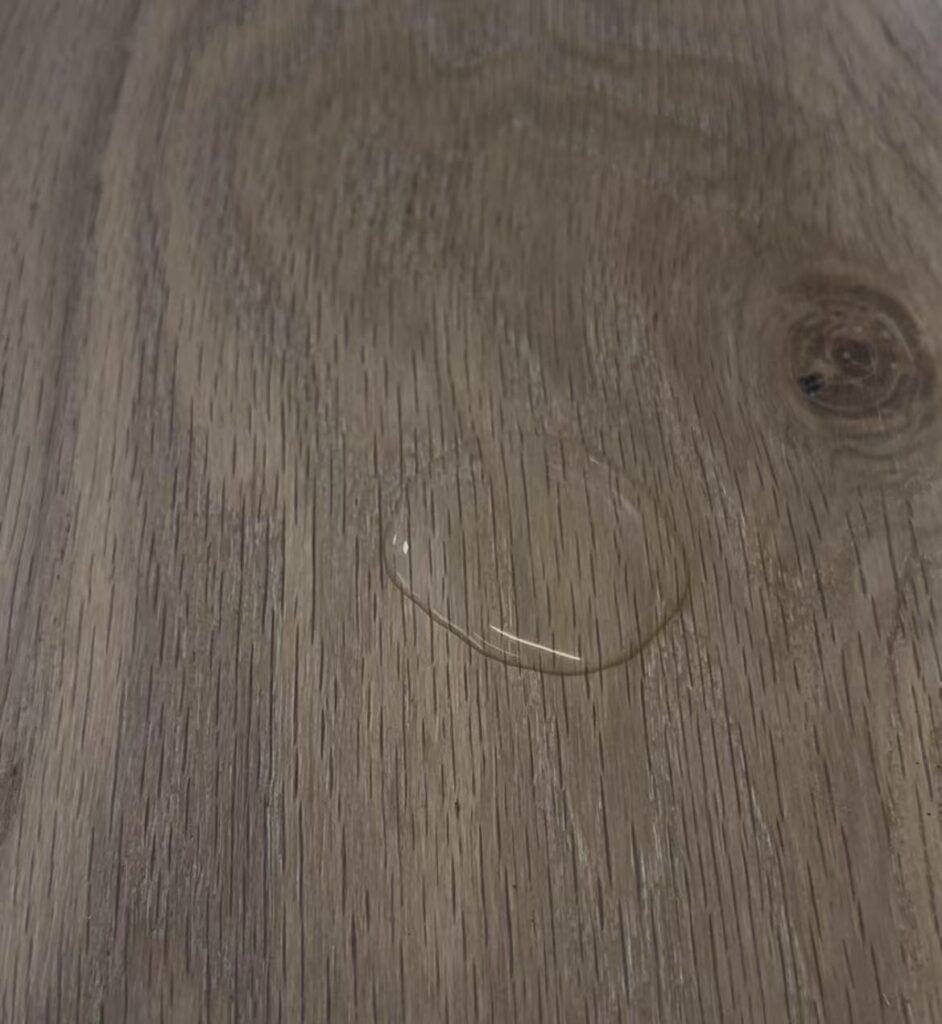Causes of Water Stains on Wooden Flooring
Water stains on wooden flooring are a common issue that can affect its appearance and, in some cases, its durability. Understanding how these stains form can help prevent and manage them effectively. Below are the main causes of water stains on wooden flooring:
- Prolonged Liquid Exposure on the Surface
Although wooden flooring is treated to be water-resistant, it is not entirely waterproof. If water, beverages, or other liquids spill onto the floor and are not wiped up promptly, they can gradually seep into the surface, leaving visible stains. The longer the liquid remains, the more likely it is to penetrate the wood fibers, making the stain difficult to remove.
- Humidity and Moisture Retention
Wood naturally absorbs and releases moisture depending on the surrounding humidity. High humidity levels or excessive moisture during cleaning can cause water to accumulate on the surface or penetrate the wood, resulting in stains. This is especially problematic in poorly ventilated areas where the flooring takes longer to dry, leading to moisture retention and visible marks.
- Damage to the Floor’s Protective Layer
Wooden flooring typically has a protective coating, such as UV-cured finishes, wear layers, or oil-based seals, which help resist moisture penetration. However, over time, or due to improper cleaning methods—such as using excessive water or harsh chemicals—this protective layer may wear down or become damaged. Once compromised, liquids can easily seep into the wood, causing stains or discoloration.
- Improper Cleaning Methods
Using excessive water while cleaning or mopping can contribute to water stains. Wooden floors, especially solid wood and laminate flooring, are sensitive to prolonged moisture exposure. If water seeps into the gaps or under the floorboards, it can cause staining or even warping. Additionally, using unsuitable cleaning agents can trigger chemical reactions with the wood surface, leaving marks that resemble water stains.
- Water Stain Residue from Sunlight Exposure
In some cases, water stains are not just a result of liquid spills but can also be caused by environmental factors. For example, in areas exposed to direct sunlight, spilled liquids may interact with the heat, accelerating evaporation and leaving behind noticeable marks or discoloration.
Water stains on wooden flooring are primarily caused by prolonged liquid exposure, humidity, surface protection wear, improper cleaning, and environmental factors. To prevent water stains, it is crucial to wipe up spills immediately, maintain proper ventilation, and use appropriate cleaning techniques.

The method for removing water stains depends on the depth of the stain:
Removing Surface-Level Stains (White Marks)
White stains indicate that moisture is trapped in the finish layer and has not penetrated deep into the wood. Try the following methods:
- Dry Cloth & Heat Treatment: Wipe the stain with a dry microfiber cloth and use a hairdryer on a low setting or an iron over a soft cloth to gently heat the area. This helps evaporate trapped moisture.
- White Vinegar or Baking Soda: Mix equal parts vinegar and water or make a baking soda paste. Apply gently with a soft cloth, rub in circular motions, then wipe dry.
- Mayonnaise or Petroleum Jelly: Apply a small amount to the stain and let it sit for a few hours before wiping it clean. These substances help draw moisture out of the wood.
- Wood Floor Polish: If the stain is still visible, applying a small amount of wood polish or mineral oil can help restore the floor’s shine.
Removing Deep Stains (Dark Marks)
Dark stains indicate that moisture has penetrated past the surface and into the wood itself. To treat these:
- Hydrogen Peroxide Method: Soak a clean cloth in hydrogen peroxide (3%), place it over the stain, and let it sit for 5-10 minutes. Remove and let the area dry, repeating if necessary.
- Sanding and Refinishing: If the stain is severe, lightly sand the affected area with fine-grit sandpaper. Then, apply a matching wood stain and reseal the area with a protective finish.
Restoring Floor Shine After Stain Removal
Once a stain is removed, the affected area may lose its natural shine. Applying wood polish, conditioning oil, or floor wax can help restore the floor’s appearance and protect it from future moisture exposure.
How to Prevent Water Stains on Wooden Flooring
Preventing water stains is the best way to maintain your wooden flooring’s beauty and longevity. Here are some effective measures:
Immediate Spill Cleanup
The most important rule is to wipe up any liquid spills immediately. Even water left on the floor for a few hours can lead to permanent stains. Keep a soft absorbent cloth or paper towel nearby for quick action.
Controlling Humidity Levels
Since wood reacts to moisture in the air, maintaining a stable indoor humidity level of 40-60% helps prevent excessive expansion and contraction. Using a dehumidifier in humid conditions or a humidifier in dry climates can help maintain balance.
Protecting the Floor with Sealants
Applying a protective coating such as polyurethane, wax, or wood oil can create a moisture barrier that reduces the risk of staining. Regularly check and reapply sealant if the existing layer starts wearing down.
Using Proper Cleaning Methods
- Avoid excessive water when mopping. Use a damp (not wet) mop and immediately dry the floor after cleaning.
- Choose wood-safe cleaning products to prevent damage to the protective finish.
- Avoid leaving wet mops or cleaning cloths on the floor for extended periods.
Using Rugs and Mats in High-Risk Areas
Strategically placing rugs and mats in areas prone to spills, such as entryways, kitchens, and near sinks, can help reduce exposure to water. Ensure mats have breathable backing to prevent moisture buildup underneath.
Minimizing Direct Sunlight Exposure
Excessive sun exposure can speed up the evaporation of moisture, sometimes leading to water stains or discoloration. Consider using curtains, blinds, or UV-protective window films to minimize this effect.




